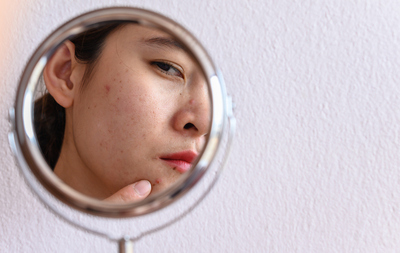Summer Skin Issues

Summer skin is not always glowy and gorgeous. Dr. Michele Farber shares some of the most common skin issues she sees during the summer months. Plus, tips on how to treat and prevent them.
Summer Skin Issue: Acne
Acne is caused by many factors, but sweating and excess oil production often mean break outs.
Here are a few tips to prevent pimples:
- Use a gentle wash twice daily and after work outs or sweating. Choose non-comedogenic or oil-free products.
- Don’t pick! This will delay healing.
- Use sunscreen, as UV rays can cause hyperpigmentation from acne. Sun protection and hats are also helpful, but don’t forget to wash your hats and sun protective clothing as well.
Summer Skin Issue: Folliculitis
This is an acne-like break out on the body caused by an infection of the hair follicles. It can flare on summer because of sweating, humidity and rubbing.
Here’s how to prevent it:
- Be sure to change out of tight clothing or a wet bathing suit.
- Be gentle with hair removal – always use shaving cream, sharp razors, and do not pick at hair. If you’re continually getting ingrowns, consult your provider about laser hair removal.
- Less common reasons are pityrosorum folliculitis, in which yeast overgrows in hair follicles, and hot tub folliculitis from improperly maintained hot tubs. These often require prescription medications but can be easily treated.
- Other causes, such as medications and other conditions can be a cause of folliculitis, so consult your dermatologist if your acne bumps aren’t resolving.
Summer Skin Issue: Prickly heat/miliaria
This happens from clogged sweat ducts in hot weather. Prevent by:
- Wearing light, breathable clothing
- Avoid outdoor activity during peak heat
- Using portable fans and staying in a cool environment can help the eruption to resolve and prevent breakouts
Summer Skin Issue: Melasma
This is a darkening of pigment on the face that worsens with sun exposure.
You can mitigate it by:
- Use a broad-spectrum sunscreen that covers UVA and UVB. A physical sun blocker like titanium dioxide or zinc oxide with a minimum of SPF 30 plus tint is best for covering the spectrum of rays that induces this type of pigment.
- Seek shade, wear hats, and use sun glasses to protect your skin.
- There’s also a hormonal basis, your provider can guide you through medications and other factors that may be flaring melasma and medications/treatments to lighten it.
Summer Skin Issue: Sun induced rashes
This ranges from photosensitivity to sunburn-like reactions. A common rash is phytophotodermatitis, a rash induced by sun exposure after contact with certain plants like limes, figs and fragrances. It presents like a sunburn and can blister. It can happen in anyone who is exposed to a predisposing chemical in sunlight and can be prevented by avoiding common offenders like limes while outside in summer.
Certain people develop a hive-like reaction when exposed to the sun. This usually only happens in predisposed individuals. It is easily managed by medications from the dermatologist.
Certain medications can also make you more sun-sensitive. These range from antibiotics to pain medication, so check your medications as well if you are breaking out in the sun and stay out of the sun if you are on a medication that causes sun sensitivity.
Summer Skin Issue: Sunburn
While we all know the perils of a sunburn, it’s important to reinforce that it causes long lasting effects. Five sunburns double melanoma risk but just one blistering sunburn in childhood can do the same.
- Prevent by wearing broad spectrum sunscreen that protects against UVA and UVB.
- Seek shade especially during peak sun exposure – 10am-2pm
- If you do burn, treat with moisturizers, pain relievers and see your provider if you are not feeling well as you can become dehydrated or need medical attention for more severe sunburns
Summer Skin Issue: Eczema flares
The hot summer weather can also cause irritated skin. While some people break out in winter, others flare in the heat of summer. If you are prone to eczema or sensitive skin, here’s how to deal with it:
- Avoid sitting outside in a wet bathing suit and shower immediately after swimming with a gentle, fragrance free cleanser.
- Don’t keep the air conditioner on the lowest settings as this can contribute dryness.
- Moisturize consistently with fragrance free moisturizer, and choose a cream over a lotion as this is more hydrating.
- Choose a mild cleanser and take shorter lukewarm showers.
Summer Skin Issue: Poison ivy/oak/sumac
These plants contain an oil that can cause an itchy, often blistering rash when they come into contact with the skin. If the rash is limited, it can often be managed at home with moisturizers, hydrocortisone cream, and antihistamine pills. If it’s more widespread, prescriptions can be helpful in speeding the resolution of the rash. You should definitely seek medical attention if you have any systemic symptoms of an allergic reaction like trouble breathing or swallowing, you have significant blistering, or it’s present in sensitive areas like the eye or groin.
Here’s how to prevent it:
- Avoid “leaves of three” and be familiar with the appearance of these plants.
- If you come into contact with these plants, wash immediately with soap and water
- Wash clothes and anything else that may have come into contact with plants to prevent spread
Summer Skin Issue: Tick-borne illnesses
Lyme, ehrlichiosis, and babesiosis are transmitted by ticks. The ticks that carry Lyme are commonly found in the northeast United States. Infected ticks can carry more than one organism and transmit the infection when they attach.
Here’s how to stay safe:
- Perform daily tick checks if you are outdoors. Be sure to check “hidden” areas including hair, behind ears, under arms, and behind knees.
- Use insect repellent.
- Remove an attached tick with tweezers immediately. The likelihood of Lyme within 24 hours of tick attachment is low, but if you develop a rash or fever seek medical attention.
How to Treat the Itching Caused by Bug Bites and Poison Ivy
“Cortisone works as an anti-inflammatory and is the most effective topical anti-inflammatory available over the counter. This reduces itch in many cases because inflammation is often the root cause of the itch,” says Dr. Jeremy Fenton. “This helps with bug bites, eczema, and allergic reactions, such as poison ivy.” Cortisone is available over the counter at a maximum concentration of 1%. Camphor and menthol are key ingredients in several popular over the counter anti-itch products, such as Sarna lotion. “These work by creating a cooling sensation on the skin which helps to distract us from the itching sensation. Similarly, itching can be helped by putting ice packs on the skin. One tip is to keep the bottle in the refrigerator for extra cooling. This doesn’t get at the root cause of the itch, but does help with the symptoms,” says Dr. Fenton.
Summer Skin Issue: Swimmer’s itch
This is a bumpy rash that occurs from parasites that burrow under the skin. It is most common in fresh water.
Here are signs and tips to treat it:
- It is usually seen in areas not covered by bathing suits.
- It is self-limited and not contagious but very itchy. Washing off as soon as you get out of the water and toweling off can clean the parasites off before they burrow.
Summer Skin Issue: Seabather’s eruption
This is an itchy rash that happens from jelly fish larvae. These can be found in contaminated waters along the Atlantic coast.
Here’s how to deal with it:
- It’s usually found as itchy bumps underneath bathing suits. Washing off as soon as you notice can prevent spread.
- Try not to scratch. The larvae release toxin from pressure.
Michele Farber, MD, FAAD is a board-certified dermatologist practicing at Schweiger Dermatology Group. Dr. Farber’s expertise includes skin cancer as well as general, cosmetic, and procedural dermatology.
